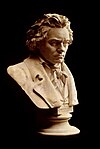Piano Concerto No. 5 (Beethoven)
The Piano Concerto No. 5 in E-flat major, op. 73 by Ludwig van Beethoven, popularly known as the "Emperor Concerto", was his last piano concerto. It was written between 1809 and 1811 in Vienna, and was dedicated to Archduke Rudolf, Beethoven's patron and pupil. The first performance took place on November 28, 1811, at the Gewandhaus in Leipzig. In 1812, Carl Czerny, his student, gave the Vienna debut of this work.
This concerto is very well known, and rather popular. In October 2007, it was voted listeners' favourite in the ABC Classic FM Classic 100 Concerto poll.[1]
Like the "Moonlight Sonata", the title of "Emperor" for this concerto was not Beethoven's own; the nickname "Emperor" is referred to exclusively in the English-speaking world.[citation needed] Its duration is approximately forty minutes.
Instrumentation
The concerto is scored for solo piano, two flutes, two oboes, two clarinets in b-flat (Clarinet I playing Clarinet in A in movement 2), two bassoons, two horns, two trumpets, timpani in E-flat and B-flat, and strings.
Movements
The "Emperor" is divided into a standard three movements:
| I. | Allegro | [ midi ] (E flat major) |
| II. | Adagio un poco mosso | [ midi ] (B major) |
| III. | Rondo: Allegro ma non troppo | [ midi ] (E flat major) |
As with Beethoven's other final concerti, this work has a relatively long first movement. (At twenty-five minutes, the Violin Concerto has the longest; Piano Concerto Nos. 4 and 5 each have opening movements about twenty minutes long.)
I. Allegro

The piece begins with three full orchestra chords, each followed by a short cadenza, improvisatory in nature but written out in the score. These short cadenzas recur intermittently throughout the piece.
As music's Classical era gave way to its Romantic era, composers began experimenting with the manner in which one or more solo instruments introduced music. Beethoven had already explored such possibilities in his Piano Concerto No. 4, but the monumental piano introduction in Piano Concerto No. 5 – it lasts for nearly two minutes – foreshadowed future concerti such as Mendelssohn's Violin Concerto or Tchaikovsky's Piano Concerto in B-flat minor.
The first movement is deceptively complex. Despite its use of simple chords, including a second theme constructed almost entirely out of tonic and dominant notes and chords, it is full of complex thematic transformations. The complexity is intensified once the piano enters with the first theme, as the expository material is repeated with far more complex variations, virtuoso figurations, and complex modified chords. The second theme enters in B major.
Aside from the opening cadenzas, the movement follows Beethoven's trademark three-theme sonata structure for a concerto. The orchestral exposition is a typical two-theme sonata exposition, but the "second exposition" with the piano has a triumphant virtuoso third theme at the end that belongs solely to the solo instrument. Beethoven does this in many of his concertos. The coda at the end of the movement is quite long, and, again typical of Beethoven, uses the open-ended first theme and gives it closure to create a satisfying conclusion.
The heroic nature of the movement is perhaps exemplified in a passage in the development section, where it seems the piano and the orchestra are going to war — and the piano wins.
II. Adagio un poco mosso
The second movement in B major is, in standard contrast to the first, calm and reflective. It moves into the third movement without interruption when a lone bassoon note B drops a semitone to B-flat, the dominant note to the tonic key E-flat.
III. Rondo: Allegro ma non troppo

The final movement of the concerto is in seven-part rondo form (ABACABA), a typical concerto finale form. The piano begins the movement by playing its main theme, then followed by the full orchestra. The rondo's B section begins with piano scales, before the orchestra again responds. The C section is much longer, presenting the theme from the A section in three different keys before the piano performs a cadenza. Rather than finishing with a strong entrance from the orchestra, however, the trill ending the cadenza dies away until the introductory theme reappears, played first by the piano and then the orchestra. In the last section, the theme undergoes variation before the concerto ends with a short cadenza and robust orchestral response.
References
- ^ Classic 100 Concerto, ABC Classic FM, Australian Broadcasting Corporation, 31 October 2007
External links
- Beethoven's Fifth Piano Concerto Analysis and description of Beethoven's Fifth "Emperor" Piano Concerto
- BBC Discovering Music (browse for .ram file containing analysis of this work)
- Piano Concerto No. 5 sheet music available at Musopen.com

